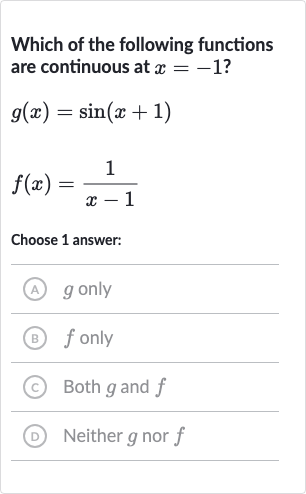Full solution
Q. Which of the following functions are continuous at ?Choose answer:(A) only(B) only(C) Both and (D) Neither nor
- Check Function Continuity: To determine if is continuous at , we need to check if the function is defined at that point and if the limit as approaches exists and is equal to the function's value at .
- Calculate : Substitute into to find .
Since the sine function is continuous everywhere, the limit as approaches of is also . - Check Function Continuity: To determine if is continuous at , we need to check if the function is defined at that point and if the limit as approaches exists and is equal to the function's value at .
- Calculate : Substitute into to find .
.
Since the function is defined at and the denominator is not zero, the function is continuous at that point. - Verify Continuity: Since both and are continuous at , the correct answer is (C) Both and .
More problems from Identify discrete and continuous random variables
QuestionGet tutor help
QuestionGet tutor help
QuestionGet tutor help
QuestionGet tutor help
QuestionGet tutor help
QuestionGet tutor help
QuestionGet tutor help
QuestionGet tutor help
QuestionGet tutor help

